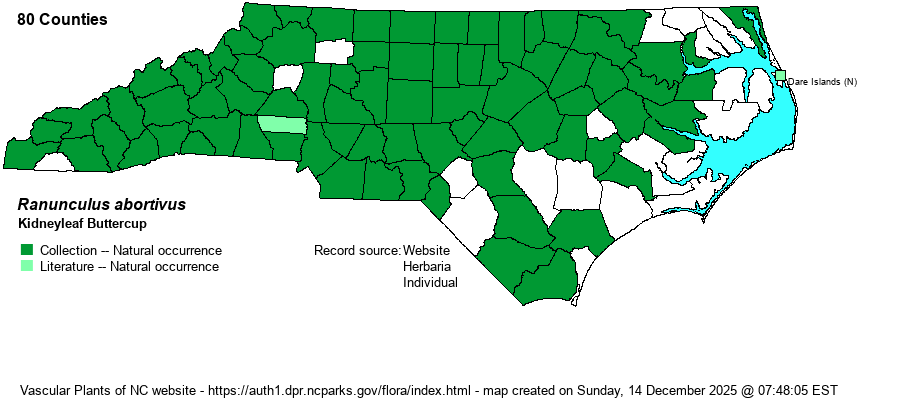| Author | L. | |
| Distribution | Throughout the Mountains, Piedmont, and western and central Coastal Plain. Nearly absent from Tidewater counties.
This is a very widespread species, ranging across much of Canada and south to the FL Panhandle and eastern TX. It is found in most counties in the states within its range. | |
| Abundance | Common to very common, and widespread, over most of the state, but much less common in the central and southern Coastal Plain. Very rare to absent in far eastern counties. | |
| Habitat | This is a species favoring damp ground, in sunny to partly sunny places, especially in bottomland forests. It favors openings in floodplains, wet thicket margins, and other low ground, but it can be found in more mesic soils as well, including lawns and roadsides -- though still preferably where a bit moist. | |
| Phenology | Blooms from March to June, and fruits shortly after flowering. | |
| Identification | This is a rather insignificant-looking buttercup, but it does have flowering stems up to about 1.5 feet high. It has distinctive basal leaves, which are on relatively long petioles about 1-2 inches long, with a kidney-shaped blade about 1 inch wide. This leaf blade is typically scalloped and generally slightly wider than long. The flowering stem has several alternate and sessile leaves, each of which is generally divided into 3 leaflets or segments, with wavy to slightly serrated margins. There are a few short branches from the upper part of the stem, each ending with a tiny flower barely 1/4-inch across, with 5 light yellow sepals. In general, this is a smooth species, which contrasts with the very rare and quite hairy C. micranthus. There are a few other similar species, but the main one for confusion is the montane C. allegheniensis (which see). This last species has the petals (which are shorter than the sepals and partly hidden in all of these species) less than half as long as the sepals, and the sepals are hirsute and swept back and not spreading, as opposed to petals greater than half as long as the sepals (which are generally free of hairs) and obviously spreading in R. abortivus. East of the mountains, you should be able to safely call any kidney-leaved or round-leaved buttercup, with tiny flowers, as R. abortivus. It can often be seen nearly every day when you are in the field, more so when walking along a floodplain greenway or other moist and partly open ground; the distinctly different basal (rounded) and stem (highly dissected) leaves is quite striking. | |
| Taxonomic Comments | None
| |
| Other Common Name(s) | Littleleaf Buttercup, Small-flowered Buttercup, Early Wood Buttercup | |
| State Rank | S5 | |
| Global Rank | G5 | |
| State Status | | |
| US Status | | |
| USACE-agcp | FACW link |
| USACE-emp | FACW link |

